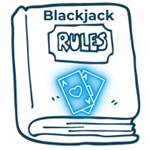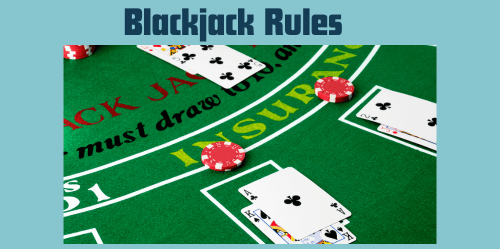Updated on: January 6th, 2025
Dive into the captivating card game of Blackjack by acquainting yourself with the strategic elements and essential rules. This comprehensive guide will equip you with the knowledge to navigate through the game's intricacies.
We'll take you on a journey from grasping the basics of card values to making smart choices during the match. Regardless of whether you're new to the game or an old hand, mastering these strategies will bolster your ability to take on the dealer with assurance. Prepare yourself for more rewarding rounds of Blackjack.
Basic Blackjack Rules
The game, often simply called '21,' challenges players to craft a hand closer to 21 than the dealer's without exceeding it. Here’s a breakdown of the game's foundational rules:
Card Values
- Number cards from 2 to 10 maintain their face value, while court cards such as Jacks, Queens, and Kings are valued at 10 points each.
- Aces are special in that players have the option to count them as either one or eleven, providing strategic flexibility.
Game Setup
In a typical Blackjack round, players receive a pair of cards face up, while the dealer gets one card face-up and another face-down.
Gameplay
- Players must decide their next move: whether to 'hit' for additional cards or 'stand' with their current hand, aiming to build a solid hand prominently.
- Landing a total of 21 with the first two cards results in a 'Blackjack' or 'natural 21,' usually leading to a boosted payout.
Dealer’s Turn
- Once all players have made their moves, the dealer will reveal their hidden card and proceed based on predetermined rules.
- Should the dealer’s hand not total 17 or more, they are obligated to 'hit' for more cards. Upon reaching a total of 17 or above, the dealer must 'stand' and desist from drawing further cards.
Losing and Winning
- When players exceed a hand total of 21, they 'bust' and forfeited that round. Conversely, if their hand value tops the dealer’s without surpassing 21, players claim victory.
- A tie between a player's and dealer's hand results in a 'push,' with the player's stake returning intact.
Payouts
- When players successfully outdo the dealer’s hand, a standard payout at even money (1:1) is typically granted.
- Scoring a 'Blackjack' on the initial deal frequently merits a premium payout, customarily at 3:2 odds.

Unique Blackjack Rules
Variants offering distinct rules can add extra flair to the game, spicing up the experience. Below are some intriguing Blackjack modifications you might encounter:
Double Down Rescue
Certain establishments feature a 'Double Down Rescue,' enabling players to forfeit their doubled bet in precarious situations, thus affording a buffer for players doubling on a less optimal hand.
Super Fun 21
In some modes, a player's 'Blackjack' will always triumph over the dealer’s, affording greater flexibility to 'Double Down' anytime, including post-split, or surrender their hand to reclaim half of their bet.
Spanish 21
The Spanish 21 variant employs a 48-card deck, removing all 10s, and offers further choices such as splitting hands several times and doubling down regardless of card amount.
Double Exposure Blackjack
The 'Face Up 21' format reveals both the dealer’s cards, granting players enhanced decision-making power, albeit with Blackjack paying just even money.
Blackjack Switch
This distinct edition of the game provides players two hands with an opportunity to swap the second card of each, improving their odds, but a dealer's 22 results in a 'push' against any player hand valued 21 or less.
No-Hole-Card Rule
In certain European Blackjack iterations, dealers forego a hole card, meaning players lose all stakes if the dealer hits a Blackjack, irrespective of their own hand outcomes.
Surrender Option
Several Blackjack formats incorporate a 'surrender' option, allowing players to concede their hand while sacrificing only half of their wager, a pragmatic tactic against a particularly daunting dealer hand.
Strategies in Blackjack
Adhering to fundamental strategies can substantially boost your winning chances when playing Blackjack:
Hit or Stand
- Opt to 'hit' if the dealer shows a 7 or higher and your total is between 12 to 16.
- Choose to 'stand' if the dealer's face-up card is 6 or less and your hand resides within the 12 to 16 range.
- Never deviate from 'standing' when your hand totals seventeen or more.
Doubling Down
- Seize the chance to 'double down' when holding an 11 unless the dealer exhibits an Ace.
- With a total of 10, double your bet unless facing a dealer's 10 or Ace.
Splitting Pairs
- Always split aces and 8s.
- Never split 5s and 10s.
Surrender
Consider surrendering a hard 16 (excluding pairs of eights) when up against a 9, 10, or Ace, and surrender a hard 15 against a dealer’s 10 when possible.
More Blackjack Guides
Blackjack Rules-FAQs
In Blackjack, the main aim is beating the dealer's hand without breaching the 21-point limit. Players receive two initial cards and have the choices to 'hit' for more or 'stand' with their existing total.
The sum of your hand comes from adding each card's value: numbered cards hold their printed value, while face cards equal 10, and Aces can swing between one or eleven.
Players can dismantle pairs of matching card values and adopt the 'double down' option by placing an extra bet and drawing one additional card.
A typical payout in Blackjack offers a 3:2 prize, meaning players gain 1.5 times their wager if they land a Blackjack.
Gaining an edge with core Blackjack techniques involves diligent study and practice, including utilizing strategy matrices and participating in free or low-stakes games to refine your skillset.







